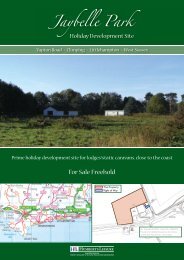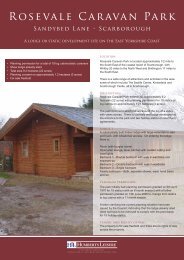Planning | Planning Gain SupplementsGoodbye Section 106 agreements,hello Planning Gain Supplements?An overview by Darren Hood.Gordon Brown feels that it may be prudent for a new tax to beimposed on windfalls enjoyed by landowners when they obtainplanning permission. This is to be called the ‘Planning GainSupplement’ (PGS). His sharp eyes have not missed the figures.Despite the growing focus on brownfield land, the Government hasnoted that on green field sites the gains are simply massive with thevalue of land rising from on average £9,000 per hectare for farmingto £2.4m per hectare for new homes (2006 figures).Current Section 106 SystemAs most developers are aware, planning and/or financial contributionsthrough a section 106 agreement is now normal practice in thedevelopment process. Indeed, research from Sheffield University in2006 has shown that the proportion of sites covered by section 106agreements has increased from 1.5% to 6.9% since 1997/8.To re-cap, planning obligations (or “s.106 agreements”) are privateagreements negotiated, usually in the context of planning applications,between local planning authorities and persons with an interest ina piece of land (or “developers”), and intended to make acceptabledevelopment which would otherwise be unacceptable in planningterms. Obligations can also be secured through unilateral undertakingsby developers. For example, planning obligations might be used toprescribe the nature of a development (e.g. by requiring that a givenproportion of housing is affordable); or to secure a contribution from adeveloper to compensate for loss or damage created by a development(e.g. loss of open space); or to mitigate a development’s impact (e.g.through increased public transport provision). The outcome of allthree of these uses of planning obligations should be that the proposeddevelopment concerned is made to accord with published local,regional or national planning policies.As a lot of new development and housing is on its way, this hasprompted this PGS proposal which is hoped to raise some £500m tofund required infrastructure. Let me set the scene further.say hello, waveBackgroundFollowing Kate Barker’s submission of the Review of HousingSupply to the Chancellor in 2004, the Government set out a packageof reforms from planning to the environment to infrastructureinvestment to deliver a step change in housing numbers: fromaround 150,000 per year to 200,000 per year by 2016.To ensure that new homes come with new infrastructure theChancellor announced a cross-cutting spending review to look athow each department in Whitehall can address the infrastructureneeds of new housing developments. A key part of these reformsbeing the creation of a Planning Gain Supplement. This involvescapturing a portion of the land value uplift arising from the planningprocess. The proposals for PGS are intended to provide a fair,efficient and transparent levy that recycles the value generatedby the planning process back into local priorities and strategicinfrastructure.The principle behind PGS is that a portion of the wealth created bythe planning system should be released to support infrastructure thatis vital to housing development, the current section 106 system beingfelt to be inadequate.ContactDarren Hood BSc(Hons) Dip UD MSc MRTPI, Brightone: darren.hood@humberts-leisure.com t: +44 (0)1273 325 911However, it was found that on the overwhelming majority of sites,no contributions were made to additional infrastructure or socialhousing. It was reported earlier this year that on 60% of medium andlarge residential sites there are no section 106 agreements, while on90% of small residential sites there are no section 106 agreements.The Government has also recognised that on commercialdevelopments too the planning contributions are currently verylimited. Some 90% of major industrial, storage or warehousing siteshave no section 106 agreements and 80% of retail, distribution orservices sites don’t either.Additionally, it was recognised that there are also limitationsto widespread use of section 106 negotiations which can beburdensome for Local Authorities as well as developers, and maybe disproportionate for large numbers of small sites. Therefore aPlanning Gain Supplement has been proposed to address theseshortfalls.Details – How Much is this Tax?The details are still unclear about the level of the PGS but it isexpected that the levy would be of the order of 20% of the uplift andwould be paid at the start of the development work. The figure hasyet to be determined by the Ministers although the Treasury hadindicated that more details would be given by the end of 2006.The Ongoing DebateAs with any proposal for a new tax the debate about its benefits anddrawbacks rage. I have listed the key arguments for and against PGS.36 Spring 2007
Planning | Planning Gain SupplementsFor PGS■■■■The principle is that there are considerablegains for landowners created by the planningsystem alone. It is only fair that a share ofthose gains should go to the local communityfor the infrastructure that makes the planninggain deliverable in practice.There is a pressing need for infrastructureinvestment.Practical measures are required to raise theadditional funds needed to accompany theextra investment the public sector is putting in.Kate Barker has suggested a value sensitivePlanning Gain Supplement, set at a modestrate in order to raise resources withoutdeterring development. Where sites do notincrease in value when planning permission isgiven, no PGS is to be paid.goodbyeAgainst PGS■■■■■■The Conservative party is opposed toPGS and has concerns that it will makedevelopment less attractive and add to theshortage of housing. Indeed, they havedescribed PGS as a stealth tax on homes andurban renewal.The house-builders have called it the‘planning-pain supplement’ as they have fearsover its impact.Smaller developers will be hardest hit as theirmargins are tighter and small scale projectsmay become unviable.There are concerns over where the tax will beused as it is to be levied at government level;it may not be invested in the communitieswhere it has been raised.The British Property Federation (BPF) haveraised three concerns about the practicalimplications of a Planning Gain Supplement:1. it is very difficult to calculate the preciseincrease in land value after planningpermission has been granted.2. developers will have to pay out the sums atthe very point when they are cash short.3. working relationships with local authoritieswill be put under pressure.With the growing focus on brownfieldland, many of those sites will experiencelittle planning gain in practice as difficultbrownfield sites have high remediation costs.On balance, there currently appear to be more opponents of the proposed Planning GainSupplement than for it in the media, but the Government will have the last say. Interestingly,the chief executive of the Royal Institution of Chartered Surveyors has suggested in thenational press that:“If PGS is introduced before the next general election, as is expected, there could be a completefreeze in development in anticipation of a new government that would scrap PGS”.Indeed, many people in the <strong>property</strong> industry are now passionate supporters of the section106 process! Some have even gone as far as to suggest the alternative of a mandatory andextended section 106 agreement would be more practicable.Lessons from the Past?History, however, may be repeating itself! Older readers may recall previous attempts torecover the increase in value from planning panning permission under the guise of the‘Development Charge’, ‘Betterment Levy’ and ‘Development Land Tax’. The ‘DevelopmentCharge’ came into effect in July 1948 and when a Conservative government took officein 1951 the financial provisions of the Town and Country Planning Act were repealed.The ‘Betterment Levy’ came into being with the Land Commission Act in 1967 and waseventually abolished by the Conservatives after they came to power in 1970. Finally, the‘Development Land Tax’ came into effect in August 1976 and when the Conservatives cameto power in 1979, this tax was reduced from 80% to 60% and was eventually repealed in theFinance Act of 1985. These previous attempts at PGS failed for a variety of reasons amongstthese are three keys:■ they required complex pieces of legislation, and the more complex a law is the more likely it will beriddled with anomalies and unintended side-effects;■ there was no recognition of the land-owners self-interests and no cognisance of increases ordecreases in land values at revaluations;■ the effect of the post-war land legislation on all three occasions (1947, 1965, 1976) was to deterdevelopment and the better use of land, to encourage land hoarding by owners and to produce anartificial scarcity of sites.We can only wait and see what the future brings this time!The Key FactsUnderstanding the proposedPlanning Gain SupplementWhat is it?The Government states that the PlanningGain Supplement (PGS), would capturea modest portion of the increase in landvalue that occurs when full planningpermission is granted. A significant majorityof PGS revenues are expected go back tothe local level to help local communitiesshare the benefits of growth and manageits impacts, with the remainder used tofinance regional and strategic infrastructureto promote growth. PGS is to be paid at thecommencement of development rather thanwhen planning permission is granted and is touse a self-assessed system of site valuations.Why is it needed?It is fair that communities share in theincreases in value landowners enjoy whenplanning permission is granted for theirland. The revenues raised by PGS wouldbe spent on the infrastructure needed tosupport new development.By reducing the scope of negotiatedplanning obligations (section 106agreements), the introduction of PGS couldhelp speed up the planning process formajor developments and reduce uncertaintyfor developers.What will it do?PGS revenues would be used to help fundthe infrastructure needed to stimulategrowth and service development, ensuringlocal communities share in the benefitsof development. A significant majorityof PGS would be recycled to the locallevel, with the remainder used to fundmajor infrastructure such as transportimprovements.Planning obligations would be scaled backto take account of PGS. Section 106 wouldapply only to items directly related to thedevelopment site, such as an access roador environmental improvements, andaffordable housing.PGS would apply UK-wide, on bothresidential and non-residentialdevelopments.What won’t it do?PGS will not apply:■ To home improvements, such as minorextensions or loft conversions.■ To sites where there is no increasein value once planning permission isgranted - it is different from the "tariff"or Optional Planning Charge previouslyconsulted on because it is proportionateto the increase in land value, notinfrastructure need.What is the timetable?The Government has consulted on itsproposals for PGS and if the Governmentdecides to proceed with implementing PGS,further consultation may be necessary, forexample on the proposed reforms to thesystem of planning obligations. Therefore PGSwould not be implemented earlier than 2008.www.humberts-leisure.com<strong>HLL</strong> <strong>Humberts</strong> <strong>Leisure</strong> 37
















